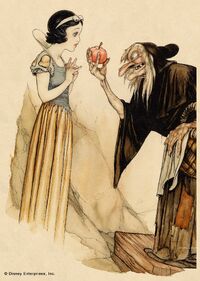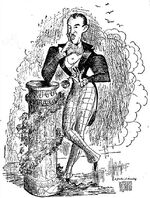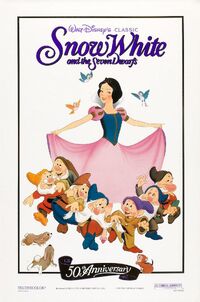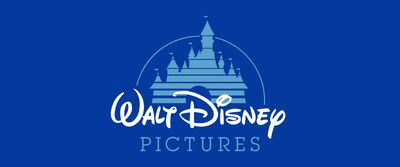Snow White and the Seven Dwarfs is the first animated feature in the Disney animated features canon. It was produced by Walt Disney Productions, premiered on December 21, 1937, and was originally released to theatres by RKO Radio Pictures on February 8, 1938. Based upon the fairy tale Snow White by the Brothers Grimm, the film's plot has a jealous queen attempt to have her stepdaughter murdered, but the girl escapes and is given shelter by seven dwarfs who live deep in a forest. Snow White was the first major animated feature made in the United States, the most successful motion picture released in 1938, and, adjusted for inflation, is the third highest-grossing film of all time.
Crew
The movie was adapted by Dorothy Ann Blank, Richard Creedon, Merrill De Maris, Otto Englander, Earl Hurd, Dick Rickard, Ted Sears and Webb Smith from the fairy tale Snow White by the Brothers Grimm. The film was supervised by David Hand, and directed by William Cottrell, Wilfred Jackson, Larry Morey, Perce Pearce, and Ben Sharpsteen.
Title card for Snow White and the Seven Dwarfs
History
"Disney's Folly"
Walt Disney had to fight to get the film produced. Both his brother Roy Disney and his wife Lillian attempted to talk him out of it, and the Hollywood movie industry mockingly referred to the film as "Disney's Folly" while it was in production. He even had to mortgage his house to help finance the film's production, which eventually ran up a total negative cost of just over $1.5 million, a whopping sum for a feature film in 1937.
Production
Snow White, which spent three years in production, was the end result of Walt Disney's plan to improve the production quality of his studio's output, and also to find a source of income other than short subjects. Many animation techniques which later became standards were developed or improved for the film, including the animation of realistic humans (with and without the help of the rotoscope), effective character animation (taking characters that look similar--the dwarfs, in this case--and making them distinct characters through their body acting and movement), elaborate effects animation to depict rain, lightning, water, reflections, sparkles, magic, and other objects and phenomena, and the use of the multiplane camera. Snow White is also looked upon as a triumph of storytelling skill in animation.

Storyboards for the chase of the Witch
Story Development
Walt Disney first revealed his plans for Snow White to his key animators after dinner one evening in 1934, when he acted out every part. Disney suggested that each of the dwarfs, whose names and personalities are not stated in the original fairy tale, could have individual personalities. The dwarfs names were chosen from a from a pool of about fifty potentials, including Jumpy, Deafy, Dizzey, Hickey, Wheezy, Baldy, Gabby, Nifty, Sniffy, Swift, Lazy, Puffy, Stuffy, Tubby, Shorty and Burpy[1]. The seven finalists were chosen through a process of elimination. Characters such as Grumpy, Happy, Sleepy, Sneezy and Bashful were relatively easily thought of. The leader of the dwarfs, required to be pompous, self important and bumbling, was named Doc. Dopey, who ultimately proved to be the most popular of the dwarfs, was the hardest character to pinpoint, and was added to the cast after animation had already begun[2]. Walt Disney encouraged all staff at the studio to contribute to the story, offering five dollars for every 'gag'; such gags included the dwarfs' noses popping over the foot of the bed when they first meet Snow White.
It was first thought that the dwarfs would be the main focus of the story, and many sequences were written for the seven characters; however, at a certain point, it was decided that the main thrust of the story was provided by the relationship between the Queen and Snow White[2]. For this reason, several sequences featuring the dwarfs were cut from the film. The first, which was animated in its entirety before being cut, showed Doc and Grumpy arguing about whether Snow White should stay with them. Another, also completely animated, would have shown the dwarfs eating soup noisily and messily; Snow White (unsuccessfully) attempts to teach them how to eat 'like gentlemen'. A partially animated sequence involved the dwarfs holding a 'lodge meeting' in which they try to think of a gift for Snow White; this was to be followed by the elaborate 'bed building sequence', in which the dwarfs and the forest animals construct and carve a bed for the princess, but was cut, as it was thought to slow down the movement of the story[2]. The soup-eating and bed-building sequences were animated by Ward Kimball, who was sufficiently discouraged by their removal to consider leaving the studio, though he ultimately decided to remain[3].

Ferdinand Hovarth drew many sketches to establish situations and locations in the film.
Other sequences were discussed in story meetings and developed in inspirational sketches. Among these was the Queen's attempt to kill Snow White with a poisoned comb, an element taken from the original story. After persuading Snow White to use the comb, the disguised Queen would have escaped alive, but the dwarfs would have arrived in time to remove it. After the failure of the comb, the Queen was to have the Prince captured and taken to her dungeon, where she would have come to him (stiory sketches show this event both with the Queen and the Witch) and used magic to bring the dungeon's skeletons to life, making them dance for him and identifying one skeleton as 'Prince Oswald'. It is written in story notes that the Queen has such magical power only in her own domain, the castle[4]. With the Prince refusing to marry her, the Queen leaves him to his death (one sketch shows the Prince trapped in a subterranean chamber filling with water[5]) as she makes her way to the dwarfs' cottage with the poisoned apple. The forest animals were to help the Prince escape the Queen's minions and find his horse. The Prince was to ride to the cottage to save Snow White, but took the wrong road (despite warnings from the forest animals and his horse, whom he, unlike Snow White, could not understand)[4]</ref>. He therefore would not have arrived in time to save her from the Queen, but would have been able to save her with love's first kiss. This entire plot was ulitmately abandoned and, though sketches were made (particularly for the capture and imprisonment of the Prince), animation on these sequences was never attempted. This was partially because of the difficulty found in animating the Prince (hence his minor role in the final film) and the fact that this storyline was considered unnecessary.

Artists such as Gustaf Tenggren introduced the influence of European illustrators.
Style
The primary authority on the design of the film was inspirational sketch artist Albert Hurter. All designs used in the film, from character's appearances to the look of the rocks in the background, had to meet Hurter's approval before being finalised[5]. Two other inspirational sketch artists contributed to the visual style of Snow White: Ferdinand Hovarth (whose designs were often thought not to be as easily translated into animation as Hurters, but who produced a number of dark concepts for the film) and Gustaf Tenggren (whose style borrowed from the likes of Arthur Rackham and John Bauer and thus possessed the European illustration quality that Walt Disney was interested in). However, only Hurter receives a credit for the film, as a character designer. Tenggren also designed the poster for the film and illustrated the press book. Other artists to work on the film included Joe Grant, whose most significant contribution was the design for the Queen's Witch form[5].
In 1935, Walt Disney travelled to Europe (with his brother Roy and their wives) on holiday for ten weeks. Disney returned from this trip with volumes of work by illustrators reccomended to him by Hurter and Grant. These illustrations, which included work by Heinrich Kley, Sir John Tenniel and Arthur Rackham, were used as a source of inspiration for the design of Snow White and many of the films that followed it[6].

The award presented to Walt Disney
At this time, Disney also encouraged his staff to see a variety of films. These ranged from the mainstream, such as MGM's Romeo and Juliet (to which Disney made direct reference in a story meeting pertaining to the scene in which Snow White lies in her glass coffin[6]), to the more obscure, including European silent cinema. The influence of german expressionism (examples of which exist in Nosferatu and The Cabinet of Dr. Calligari, both of which were recommended by Disney to his staff) can be found in Snow White (as well as the two films to follow it), particularly in the scenes of Snow White fleeing through the forest and the Queen's transformation into the Witch[6]. The latter was also inspired by 1931's Dr. Jekyll and Mr. Hyde, to which Disney made specific reference in story meetings[6].
Critical and commercial success
Snow White and the Seven Dwarfs premiered at the Carthay Circle Theater on December 21, 1937 to a widely receptive audience (many of whom were the same naysayers who dubbed the film "Disney's Folly"), who gave the film a standing ovation at its completion. RKO Radio Pictures put the film into general release on February 4 1938, and it went on to become a major box-office success, making more money than any other motion picture in 1938. In fact, for a short time, Snow White was the highest grossing film in American cinema history; it was removed from that spot by Gone With the Wind in 1940.
 Hirschfeld's caricature of Disney, as a Hollywood darling —Al Hirschfeld[7] |
A subject of particular criticism was the film's depiction of Snow White, the Queen and the Prince as realistic human figures, which caused some (including successful New York caricaturist Al Hirschfeld) to believe that Disney was too closely following live-action and realism, thus rejecting the qualities that made cartoons such as the Silly Symphonies unique.[7]
Certain scenes in Snow White and the Seven Dwarfs, particularly those featuring the Witch, are regarded as some of Disney's most frightening moments; British censors considered the film frightening enough for young viewers to have to be accompanied by an adult[8]. Animators such as Frank Thomas and Ollie Johnston, felt that Walt Disney restrained his animators from creating such a terrifying villain again. Later films such as Pinocchio and Fantasia would receive similar accusations for their frightening and intense sequences.
Snow White and the Seven Dwarfs was the first full-length animated feature made in English and Technicolor, and won an honorary Academy Award for Walt Disney "as a significant screen innovation which has charmed millions and pioneered a great new entertainment field." Disney received a full-size Oscar statuette and seven miniature ones, presented to him by Shirley Temple.
The movie was also nominated for Best Music, Score. Well-known songs from the film include: "Heigh-Ho", "Some Day My Prince Will Come", and "Whistle While You Work".
Re-release schedule and home video
Snow White and the Seven Dwarfs was first re-released in 1944, in order to raise revenue for the Disney studio during the World War II period. This re-release set a tradition of re-releasing Disney animated features every seven years, and Snow White was re-released to theatres in 1952, 1958, 1967, 1975, 1983, 1987, and 1993. The film was restored for its 1987 fiftieth anniversary re-release; a more comprehensive digital restoration was done for the 1993 re-release.
A Russian 1955 poster promoting the film
Snow White was first released on home video in 1994, and was released on Disney DVD in 2001. The Snow White DVD was the first in Disney's Platinum Series line of releases, and featured, across two discs, the digitally restored film, a making-of documentary, an audio commentary by John Canemaker and (via archived audio clips) Walt Disney, and many more special features.
Trivia
- The movie's title uses the word "dwarfs" which was the traditional plural of "dwarf". The Lord of the Rings by John Ronald Reuel Tolkien, published in three volumes from 29 July, 1954 to 20 October, 1955, instead popularised the spelling "dwarves". Both plural forms have been used interchangeably since then.
- A version with live actors based on the film, titled Snow White: The Fairest of Them All and starring Kristin Kreuk, was made in 2002.
- A live action martial arts version, called Snow and the Seven will be coming out in 2006.
- Upon seeing the film, Russian director Sergei Eisenstein called it the greatest ever made.
- The song, "Someday My Prince Will Come" has become a jazz standard that has been performed by numerous artists, including Buddy Rich, Oscar Peterson, and Miles Davis.
- There are numerous popular ideas as to the presence of occult significance or symbolism within the movie, mostly centered around the Dwarves themselves. For example, one theory holds that the seven dwarves correspond to the seven chakras (or cakras), and that Snow White represents consciousness moving through them. Other ideas are less philosophically complex, such as correspondences to the altered states of consciousness inherent in the use of certain drugs. In one theory, Snow White is cocaine, which causes exhaustion (Sleepy), mood swings (Happy, Grumpy), allergies (Sneezy) and alteration of personality (Bashful, Dopey) eventually resullting in a trip to the doctor (Doc)). More on this
Characters (in order of appearance)
| Character | Vocal Talent | Supervising animator | Notes |
|---|---|---|---|
| Queen | Lucille La Verne | Art Babbit Norman Ferguson |
Snow White's vain and jealous stepmother, who plots to have the princess killed and transforms into the Witch. |
| Magic Mirror | Moroni Olsen | Wolfgang Reitherman | The Queen's slave, who must speak the truth, and reveals that Snow White is the fairest of all. |
| Snow White | Adriana Caselotti | Hamilton Luske | The fairest of all, loved by all but the jealous Queen. |
| Prince | Harry Stockwell | A handsome hero who falls in love with Snow White. | |
| Humbert the Huntsman | Stuart Buchanan | The Queen's faithful servant, reluctant to kill Snow White. | |
| Forest Animals | None | The inhabitants of the forest, who befriend Snow White and lead her to the Cottage of the Seven Dwarfs. | |
| Happy | Otis Harlan | Vladimir Tytla Frank Thomas |
The jolliest of the dwarfs, with a cheerful giggle. |
| Grumpy | Pinto Colvig | Vladimir Tytla | The grouchiest, but arguably most competent and capable, of the dwarfs. |
| Bashful | Scotty Mattraw | Vladimir Tytla Frank Thomas |
The most shy of the dwarfs, secretly in love with Snow White, and with a tendancy to blush. |
| Sleepy | Pinto Colvig | Vladimir Tytla Frank Thomas |
The most weary of the dwarfs, with droopy eyes; constantly bothered by a pesky fly. |
| Sneezy | Billy Gilbert | Vladimir Tytla Frank Thomas |
A dwarf with hayfever, whose sneezing is a constant nuisance to the other dwarfs. |
| Fly | None | An insect that constantly annoys Sleepy and prevents him from getting any sleep. | |
| Doc | Roy Atwell | Vladimir Tytla | The pompous, self-appointed leader of the dwarfs. |
| Dopey | Eddie Collins | Frank Thomas | The youngest of the dwarfs; not stupid, but with the personality and mannerisms of a puppy. |
| Raven | None | The Queen's silent familiar. | |
| Vultures | None | Two birds whose arrival heralds approaching death. |
Attractions
Snow White has a ride in 4 of the 5 resorts. These are:

The poster for the 1987 re-release
Disneyland
- Grand opening: July 17, 1955
- Re-dedication: May 23, 1983
- Name: Snow White's Scary Adventures
- Designers: WED Enterprises
- Maximum seating capacity: 4 per mine car
- Show length: roughly 2 minutes
- Required ticket: "C"
- Ride system: Dark ride
The Magic Kingdom
- Grand opening: October 1, 1971
- Re-dedication: December 1994
- Name: Snow White's Scary Adventures
- Designers: WED Enterprises
- Maximum seating capacity: 4 per mine car (1971 version); 6 per mine car (1994 version)
- Show length: roughly 2:50
Tokyo Disneyland
- Grand opening: April 15, 1983
- Name: Snow White's Adventures
- Designers: WED Enterprises
- Maximum seating capacity: 4 per mine car
- Show length: 2:30
- Ride system: Dark ride
Disneyland Paris
- Grand opening: April 12, 1992
- Name: Blanche-Neige et les Sept Nains
- Designers: Walt Disney Imagineering
- Maximum seating capacity: 6 per mine car
- Show length: roughly 2 minutes
- Ride system: Dark ride
References
- ↑ Bob Thomas, "Disney's Art of Animation: From Mickey Mouse to Beauty and the Beast"
- ↑ 2.0 2.1 2.2 Frank Thomas and Ollie Johnston, "The Illusion of Life: Disney Animation"
- ↑ John Canemaker, "Walt Disney's Nine Old Men and the Art of Animation" (Disney Editions, United States, 2001) ISBN 078686496-6
- ↑ 4.0 4.1 Snow White and the Seven Dwarfs production timeline (DVD feature)
- ↑ 5.0 5.1 5.2 John Canemaker, "Before the Animation Begins: The Life and Times of Disney inspirational Sketch Artists"
- ↑ 6.0 6.1 6.2 6.3 Bruno Girveau (editor), "Once Upon a Time: Walt Disney"
- ↑ 7.0 7.1 Al Hirschfeld, An Artist Contests Mr. Disney
- ↑ George Perry, How Disney Makes Magic: Creating Character (Sunday Times Supplement, 1999)
External link
Template:Imdb title
| v - e - d | ||||||||||||||||
|---|---|---|---|---|---|---|---|---|---|---|---|---|---|---|---|---|
|
Template:Animated Feature-nav
| This page uses content from the English Wikipedia page Snow White and the Seven Dwarfs. The list of authors can be seen in the page history. Text from Wikipedia is available under the Creative Commons Attribution-ShareAlike License; additional terms may apply. |


